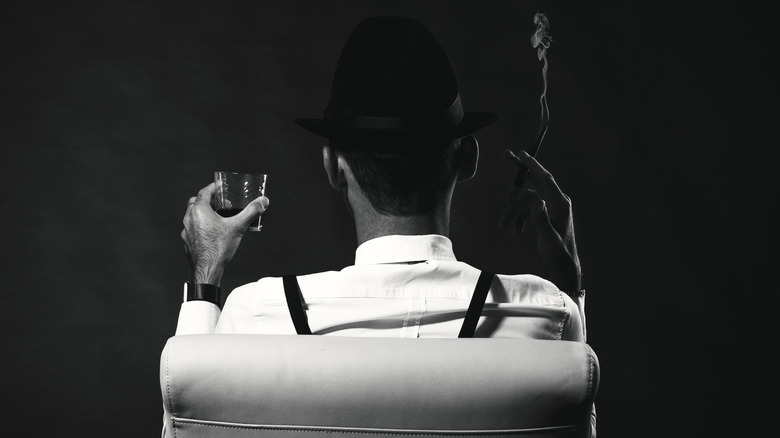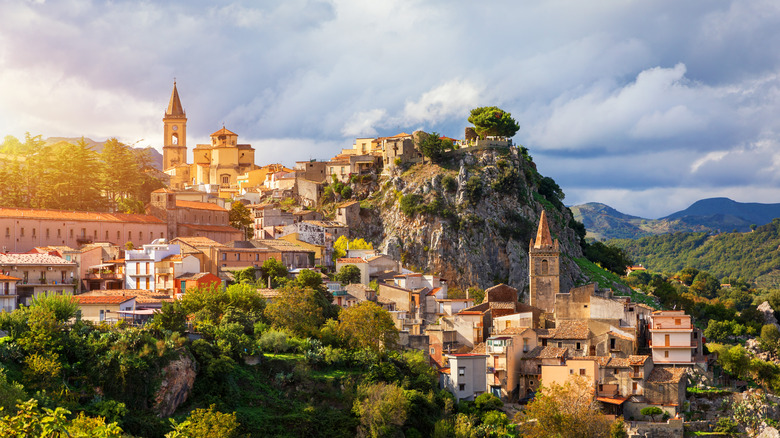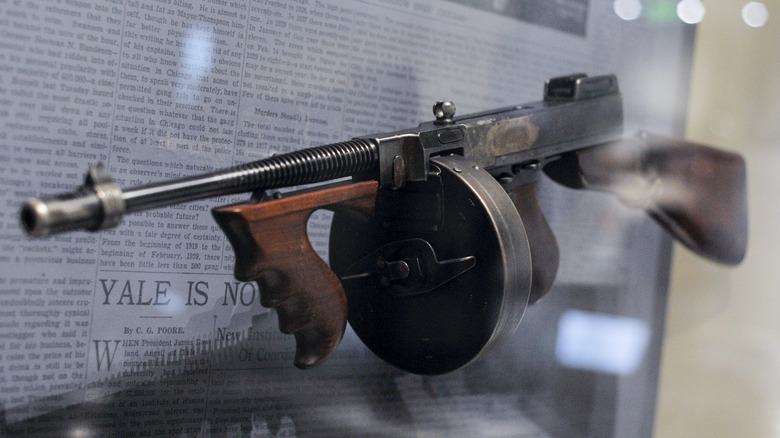The Dark Origins Behind The Sicilian Mafia Explained
Ah ... Sicily. Gorgeous turquoise seas lapping the shoals near ancient Roman architecture spanning off towards green-tufted mountainscapes. Beaches, cute little fishing boats, clear skies, amazing food, and, of course, a ruthless and sadistic mafia hell-bent on incendiary violence to settle centuries-old familial vendettas. Who doesn't love Italy?
Many of us are familiar with the Hollywood version of the Sicilian mafia, more properly called "La Cosa Nostra," tellingly (if underwhelmingly) translated as "Our Thing." We've got Marlon Brando cotton-stuffing his lower lip in 1972's "The Godfather" to aid his bulldog delivery of the "I'm gonna make him an offer he can't refuse" line. We've got "Goodfellas" (1990), "Casino" (1995), "The Sopranos" (1999-2007), the "Godfather" sequels, and countless more nods, spin-offs, movies, video games, and more. It's no exaggeration to say that organized crime stories, particularly those centered on the Sicilian mafia, are something of a cultural obsession that speaks volumes about our own disturbed preoccupations.
But where did the mafia, and its mafiosi, actually come from? Did it start as organized crime networks of drug trafficking, racketeering, protection money, baseball bats to kneecaps, and so on? Is it all as grim, savage, and heartless as fiction depicts? Well, don't go asking any single mafioso. Even though "mum" might not be the word, "omertà" — the mafia's "law of silence" — definitely is.
Birthed in the aftermath of the Italian unification of 1871
To understand the origins of the Sicilian mafia, we've first got to remember that until 1871, Italy wasn't a unified country. It was a chopped up cluster of jigsaw-bordered kingdoms such as Sardinia, the Grand Duchy of Tuscany, the Papal States, and more. Europe was largely a mess of wars, falling kingdoms, rising empires, and ethnic mishmashes through much of the late 1700s through the mid-20th century, when many of our modern states cohered into their current forms. As Vox shows us, what's now known as Italy took shape after the final piece of the land puzzle, the Papal States, were annexed by the nascent Italian government in 1870, and Rome became the capital in 1871.
The "Kingdom of Italy" had an immense task before it: overhaul its governing bodies and lawmaking procedures, protect its people, and also unify language and culture in a single go. Things fell through the cracks. Lawlessness abounded. How about hiring mercenaries — entire local, tribal clans to go after other criminal enterprises, as History tells us? Sure. What could go wrong?
These clans constitute the origins of our modern mafia, centered on gabellotto, wealthy enforcer-employing landowners who leased their land to royalty and farmers who would eventually become unable to pay their debts, as We Are Palermo explains. These individuals formed the hubs of power-brokering groups, or cosche, who created sets of regional alliances across Sicily, per the book "Men of Respect: A Social History of the Sicilian Mafia," reviewed at Organized Crime.
Vigilantism and mistrust of authority built from traditional Sicilian culture
From the get-go the Sicilian mafia wasn't composed of mere thugs and reprobates. Organization and loyalty, initiations and kinship stirred into governmental corruption: These were the ingredients that gave "La Cosa Nostra" — the Sicilian mafia, as opposed to other mafia groups — strength. And these ingredients, as Organized Crime explains, have roots in traditional Sicilian culture "which endorses the use of violence for the achievement of economic goals" and emphasizes a distinction between landowners and peasants.
When Italy became unified, "mafioso" simply meant "someone mistrustful of authority," as History says. The term grew organically from its roots as Sicilian-Arabic slang meaning "acting as a protector against the arrogance of the powerful," which segues neatly into anti-authoritarian vigilantism. An 1860s Italian play called "I Mafiusi della Vicaria" ("Heroes of the Penitentiary"), about "a group of inmates at a Sicilian prison ... who maintained their own hierarchy and rituals," popularized the use of the word "mafia." It's ironic that such antigovernmental "heroes of the people" were the ones engaging in shakedowns of landowners and peasants alike for "pizzo," or protection money, their main source of income, as We Are Palermo states.
So when the Italian government, and eventually the church, conscripted La Cosa Nostra to do their policing dirty work, neither thought the situation would be permanent. The blind eye they turned to extra-legal bribery and bullying went on to affect all levels of Sicilian economy and politics, and even spread abroad.
La Cosa Nostra goes global
As the FBI's website states, it didn't take long at all for Cosa Nostra to emigrate to the United States. In 1881, a mere 10 years after the unification of Italy, Giuseppe Esposito and six other mafiosi were extradited back to Italy after fleeing to New York following the murders of a province's chancellor, vice-chancellor, and 11 "wealthy landowners." In 1890 the trail of blood and bodies continued, when New Orleans Police Superintendent David Hennessey was found "murdered execution-style." Hundreds of Sicilians were arrested, 19 were indicted for Hennessey's murder, and all of them were acquitted in what appeared to be another case of Cosa Nostra bribery and bullying at play. The public cried foul, and in their own demonstration of vigilantism, rounded up whatever defendant they could find and executed them. Eight survived.
Fast forward through the decades and we've got Al Capone's Chicago mafia vs. Eliot Ness and The Untouchables in the 1920s, while La Cosa Nostra in New York became embroiled in power plays. Joseph Masseria tried to wrangle all the groups in the U.S. under one organization and was murdered in 1931 in a conspiracy between Salvatore Maranzano and Charles "Lucky" Luciano. Luciano then murdered Maranzano to take all the power for himself and use his position "to run La Cosa Nostra like a major corporation."
Fast forward some more and we've got romanticized Scorsese films like "Goodfellas" featuring demented funnyman Joe Pesci, and Tony Soprano going to therapy with Dr. Melfi in "The Sopranos."
La Cosa Nostra lives on to this day
Out of all the codes and fear necessary to hold La Cosa Nostra together, "omertà" stands out: protective silence of the clan, built on the belief that authorities were incapable of levying true justice. Sicily's 19th-century false liberators, though — and members of any family, for that matter — have long since stopped being silent or hiding.
As NDTV tells us, nigh-untouchable clan descendants such as Lucia Riina, youngest child of former "boss of bosses" Salvatore "Toto" Riina, is getting a "shame on you" finger-wag for capitalizing on her family's fame to decorate a new Parisian restaurant where she works with iconography from the town of Corleone. The headline in question calls her out as "daughter of Italian mafia boss," right out in the open; she says she's just a waitress. Meanwhile, in Italy, Cosa Nostra boss Giovanni Brusca was released from jail after having been arrested in 1996 for the murder of Italy's "legendary anti-Mafia judge" Giovanni Falcone, per the BBC. Falcone was responsible for Italy's utilization of "collaboratori di giustizia" — defectors — to oust mafia goings-on. Italians in Palermo, Sicily are outraged and afraid, and at the same time receiving COVID-19 face masks and food supplies from mafia families like the Pagliarelli clan, perhaps in exchange for eventual favors.
As Organized Crime quotes, "By the end of the 19th century the mafia firmly represented part of the civil and political society of central-western Sicily and of its links to the state." This definitely still rings true today.
The documentary "Vendetta: Truth, Lies and the Mafia" streams on Netflix September 24. The trailer is posted on YouTube.




